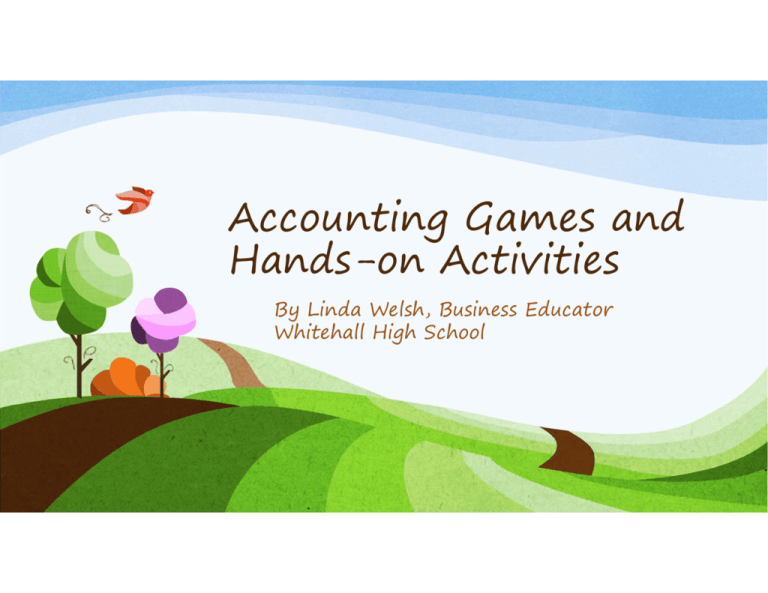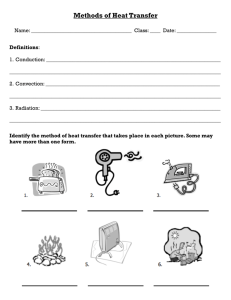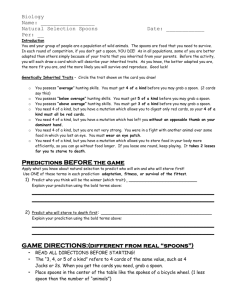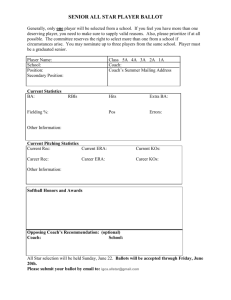Accounting Games and Hands
advertisement

Accounting Games and Hands-on Activities By Linda Welsh, Business Educator Whitehall High School Linda Welsh, Business Educator Whitehall High School Accounting Photoshop Web design Computer applications Business management Entrepreneurship Let your feet do the talking! If this session isn’t for you, feel free to walk out at anytime and find something more suitable. Your time is valuable! If you have a gmail account, write your gmail down so I can share the Google Doc and Presentation with you. OR If you want the materials emailed to you, write your school email down; and I will email everything to you. OR If you have a flash drive, I can transfer all my files to your drive after the session. Chalk Talk The teacher will write a topic. The teacher must correct any wrong concepts if another student doesn’t make a correction. Each student must write four items – 2 of which must break off from someone else’s post (these rules can be adapted for your situation) No talking by the students Group discusses purpose of activity. Fly Swatter Game Teacher will arrange the students into small groups. Each student will receive a fly swatter The teacher will have a set of questions ready to ask students. Students will be in ready position – elbow on table Teacher reads a question and then tells students to go. Students slap the correct answer on the table. JENGA Teacher will number each wooden piece. For each Jenga group, the teacher will make one copy of review questions. Teacher will arrange the students into small groups. Students will play Jenga – answering question with the number of the Jenga game piece pulled. Student will keep piece if question is answered correctly. The Building Supervisor (student asking questions) will get the piece if the student answers incorrectly. Hollywood Squares Teacher will prepare questions. Teacher will prepare activity cards— nine X and O cards—stars optional. Teacher will identify nine participants and then divide the remaining students into two groups—X’s and O’s. Teacher will arrange participants (stars): three will stand, three will sit in chairs and three will sit on floor. Teacher will explain that the object of the game is to create a tic-tac-toe in a row across, diagonally, or down. Hollywood Squares cont. Teacher will choose a team to begin—team will select a star. Teacher will read a question to the person holding the star. Student holding star will answer the question. The star may choose to answer the question correctly or incorrectly. After the star answers, the team chooses to agree or disagree. If the team is correct, then the team gets that square. The star then shows the X or the O that corresponds with the team. Play moves to the next team. If the team is incorrect, the other team gets the star. However, you can’t win a game on an incorrect answer. True and False – Chair Race Teacher will divide participants into two teams. Teacher will place a TRUE sign on one chair and FALSE on another chair. Teacher will have one team sit on one side of the chairs and other team sit on the other side. Teacher will start at one end of the chairs. Participants will compete against the person sitting behind them on the opposing team. If there is an odd number of participants, the competitor may change every time by moving to the next person available for each team. True and False – Chair Race cont. Teacher will read a true or false question. The competing participants decide if the answer is true or false, and “walk” to the appropriate chair. The participant who sits in the correct chair first wins one point for his/her team. Teacher will keep score on the board or on a piece of paper. After the score is recorded, participants return to their original chairs. Play moves to the next two participants. If both participants answer wrong, no points are awarded and the play moves to the next two participants. Kahoot https://getkahoot.com/ Spoons Teacher will need 1 spoon for every participant and a set of activity cards that can be matched (one set for each group). Teacher will designate a participant as the “spoonmaster” (one per group). This participant is in charge of checking the answers as needed. The spoonmaster will arrange the spoons in the center of the table, an equal distance from all players--remove one spoon--there should be one less spoon available than players. Teacher will designate a dealer per group. The dealer deals three cards to each player and keeps the remaining cards in a stack. Spoons cont. The dealer quickly takes a card from the deck and can either: Keep the card and pass one card from his/her hand to the player on his/her left or pass the card selected to the player to the left. Players continue quickly passing the one card from the dealer or a different card from their hand to the player on his or her left, attempting to make a pair in their hand. Players should always have three cards in their hand. Once a player has what they think is a correct pair, they take a spoon from the middle of the table. Once a spoon has been taken, remaining players should quickly grab the remaining spoons. Spoons cont. The spoonmaster must then verify that the match of the player first taking a spoon was correct. If it was, the player who did who did not get a spoon is out of that round. If it was not a correct match, the player who took the first spoon is out. For the next round, the player who was eliminated automatically becomes the spoonmaster, and one spoon is taken off of the table. Play continues until there are only two players remaining and one spoon. The winner is the participant who gets that spoon with a correct match. I love teaching accounting and finding fun things to add to my classroom. What kind of activities do you like to do in your class?







